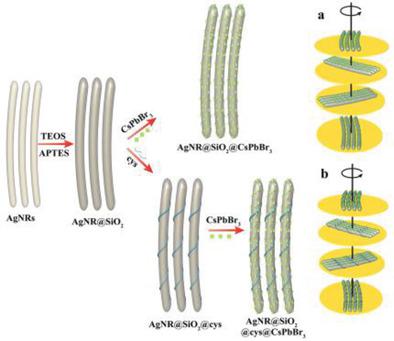当前位置:
X-MOL 学术
›
Part. Part. Syst. Charact.
›
论文详情
Our official English website, www.x-mol.net, welcomes your
feedback! (Note: you will need to create a separate account there.)
Self‐Assembly of Chiral Nematic Liquid Crystalline Phases of AgNR@SiO2@Cysteine@CsPbBr3 Hybrid Nanorods with Plasmon‐Dependent Photoluminescence
Particle & Particle Systems Characterization ( IF 2.7 ) Pub Date : 2020-02-20 , DOI: 10.1002/ppsc.202000008 Zhen Li 1 , Huali Liu 1 , Fei Li 1 , Jiaqi Zhao 1 , Yu Wang 1
Particle & Particle Systems Characterization ( IF 2.7 ) Pub Date : 2020-02-20 , DOI: 10.1002/ppsc.202000008 Zhen Li 1 , Huali Liu 1 , Fei Li 1 , Jiaqi Zhao 1 , Yu Wang 1
Affiliation

|
The direct synthesis of a chiral nematic liquid crystalline phase of AgNR@SiO2@cysteine@CsPbBr3 hybrid nanorods (HNRs) is reported. The circular dichroism spectra can be divided into three components: (1) the interband absorption–enhanced optical activity of structural arrangement of cysteine (cys) molecules, 200–320 nm, (2) the chiral nematic liquid crystalline arrangement of the Ag nanorods (AgNRs), 350–450 nm, and (3) the exciton adsorption edge of the perovskite, 500–550 nm. The polarizing optical microscope images indicate that the chiroptical response of perovskite arises from chiral nematic crystalline arrangement rather than cys‐induced electronic coupling between a chiral ligand and otherwise achiral perovskite quantum dots (QDs). The luminescent intensity of CsPbBr3 QDs in AgNR@SiO2@cys@CsPbBr3 HNRs is boosted 87‐fold due to the local surface plasmon resonance field enhancement effect. Furthermore, the high‐performance green light emitting diode is constructed employing AgNR@SiO2@cys@CsPbBr3 complexes, which exhibit excellent luminescent properties. This work contributes insights into structure–property relationships and this strategy promisingly provides guidance for the other inorganic chiral semiconductor suprastructures.
中文翻译:

AgNR @ SiO2 @ Cysteine @ CsPbBr3纳米棒的手性向列液晶相的自组装与等离激元相关的光致发光
报道了AgNR @ SiO 2 @半胱氨酸@CsPbBr 3杂化纳米棒(HNRs)的手性向列液晶相的直接合成。圆二色性光谱可分为三个部分:(1)200-320 nm的半胱氨酸(cys)分子结构排列的带间吸收增强的光学活性,(2)Ag纳米棒的手性向列液晶排列( AgNRs)在350–450 nm之间;(3)钙钛矿的激子吸附边缘在500–550 nm之间。偏光光学显微镜图像表明,钙钛矿的手性响应来自手性向列晶体排列,而不是手性配体与非手性钙钛矿量子点(QD)之间的半胱氨酸诱导的电子偶联。CsPbBr的发光强度由于局部表面等离子体激元共振场的增强作用,AgNR @ SiO 2 @ cys @ CsPbBr 3中的3个量子点提高了87倍。此外,高性能的绿色发光二极管采用AgNR @ SiO 2 @ cys @ CsPbBr 3配合物构建,具有出色的发光性能。这项工作有助于深入了解结构与属性之间的关系,并且该策略有望为其他无机手性半导体超结构提供指导。
更新日期:2020-02-20
中文翻译:

AgNR @ SiO2 @ Cysteine @ CsPbBr3纳米棒的手性向列液晶相的自组装与等离激元相关的光致发光
报道了AgNR @ SiO 2 @半胱氨酸@CsPbBr 3杂化纳米棒(HNRs)的手性向列液晶相的直接合成。圆二色性光谱可分为三个部分:(1)200-320 nm的半胱氨酸(cys)分子结构排列的带间吸收增强的光学活性,(2)Ag纳米棒的手性向列液晶排列( AgNRs)在350–450 nm之间;(3)钙钛矿的激子吸附边缘在500–550 nm之间。偏光光学显微镜图像表明,钙钛矿的手性响应来自手性向列晶体排列,而不是手性配体与非手性钙钛矿量子点(QD)之间的半胱氨酸诱导的电子偶联。CsPbBr的发光强度由于局部表面等离子体激元共振场的增强作用,AgNR @ SiO 2 @ cys @ CsPbBr 3中的3个量子点提高了87倍。此外,高性能的绿色发光二极管采用AgNR @ SiO 2 @ cys @ CsPbBr 3配合物构建,具有出色的发光性能。这项工作有助于深入了解结构与属性之间的关系,并且该策略有望为其他无机手性半导体超结构提供指导。


















































 京公网安备 11010802027423号
京公网安备 11010802027423号